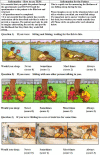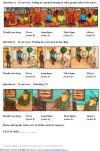The Top End Sleepiness Scale (TESS): A New Tool to Assess Subjective Daytime Sleepiness Among Indigenous Australian Adults
- PMID: 33707978
- PMCID: PMC7941568
- DOI: 10.2147/NSS.S298409
The Top End Sleepiness Scale (TESS): A New Tool to Assess Subjective Daytime Sleepiness Among Indigenous Australian Adults
Abstract
Purpose: To illustrate the utility of a newly developed culturally safe and clinically relevant subjective daytime sleepiness assessment tool "Top End Sleepiness Scale" (TESS) for use among Indigenous Australians.
Patients and methods: The TESS questionnaire consists of pictorial representations of 6 items representing daily activities that would induce daytime sleepiness specific for Indigenous Australians living in the regional and remote Australia. Consecutive adult Indigenous patients who consented to pilot the TESS questionnaire prior to undergoing a diagnostic polysomnography (PSG) at the Top End Health Service region, Northern Territory of Australia were assessed. The TESS questionnaire was evaluated for its correlation in predicting obstructive sleep apnea (OSA) according to apnea-hypopnea index.
Results: Eighty-two patients were included. The majority (70%) had moderate to severe OSA (AHI ≥15). Patients were aged in their mid-40's (45.47 95% CI (42.9, 48.05)) with a tendency to obesity (median BMI 33.67 IQR 30.86, 38.95) and a high prevalence of chronic conditions (72%) (hypertension, diabetes or heart disease). The TESS showed high internal consistency (Split half Spearman correlation=0.71, Cronbach's α =0.81), and a cut-off value ≥3 resulted in sensitivity 84%, specificity 38%. Comparison of area under the curve for TESS to Epworth Sleepiness Scale (ESS) in this sample showed the TESS to have greater sensitivity and specificity overall, which approached significance (p=0.072) when cut-off values of ≥3 and ≥8 (TESS & ESS respectively) were used. The sensitivity and specificity for TESS was also comparable to the other currently used questionnaires, such as the Berlin Questionnaire, STOP-BANG and OSA 50.
Conclusion: Currently, there are no subjective daytime sleepiness assessment toll available specifically for Indigenous population. The proposed TESS sleepiness screening tool represented in this study can potentially complement or adopted alongside other existing questionnaire, which may offer greater utility in the assessment of sleep disorders among Indigenous people.
Keywords: Aboriginal; Epworth Sleepiness Scale; First Nations; Sleepiness Scale; indigenous; subjective daytime sleepiness.
© 2021 Benn et al.
Conflict of interest statement
All authors declare no conflicts of interest for this work.
Figures





Similar articles
-
Validity of the new 'Top End Sleepiness Scale' against the STOP-Bang tool in predicting obstructive sleep apnoea among Indigenous Australian adults.Intern Med J. 2023 Mar;53(3):339-347. doi: 10.1111/imj.15633. Epub 2022 Aug 24. Intern Med J. 2023. PMID: 34800328
-
[Risk for sleep apnea syndrome and excessive daily sleepiness in chronic hemodialysis patients].Acta Med Croatica. 2011 Oct;65 Suppl 3:30-5. Acta Med Croatica. 2011. PMID: 23120812 Croatian.
-
Epworth Sleepiness Scale may be an indicator for blood pressure profile and prevalence of coronary artery disease and cerebrovascular disease in patients with obstructive sleep apnea.Sleep Breath. 2012 Mar;16(1):31-40. doi: 10.1007/s11325-011-0481-5. Epub 2011 Jan 19. Sleep Breath. 2012. PMID: 21243439
-
Comparison of Berlin Questionnaire, STOP-Bang, and Epworth Sleepiness Scale for Diagnosing Obstructive Sleep Apnea in Persian Patients.Int J Prev Med. 2018 Mar 9;9:28. doi: 10.4103/ijpvm.IJPVM_131_17. eCollection 2018. Int J Prev Med. 2018. PMID: 29619152 Free PMC article.
-
Diagnostic accuracy of the Berlin questionnaire, STOP-BANG, STOP, and Epworth sleepiness scale in detecting obstructive sleep apnea: A bivariate meta-analysis.Sleep Med Rev. 2017 Dec;36:57-70. doi: 10.1016/j.smrv.2016.10.004. Epub 2016 Nov 5. Sleep Med Rev. 2017. PMID: 27919588 Review.
Cited by
-
The Effects of Inhaled Airway Directed Pharmacotherapy on Decline in Lung Function Parameters Among Indigenous Australian Adults With and Without Underlying Airway Disease.Int J Chron Obstruct Pulmon Dis. 2021 Sep 29;16:2707-2720. doi: 10.2147/COPD.S328137. eCollection 2021. Int J Chron Obstruct Pulmon Dis. 2021. PMID: 34616149 Free PMC article.
-
Sex differences in pulmonary function parameters among Indigenous Australians with and without chronic airway disease.PLoS One. 2022 Feb 8;17(2):e0263744. doi: 10.1371/journal.pone.0263744. eCollection 2022. PLoS One. 2022. PMID: 35134094 Free PMC article.
-
Comparison and outcomes of emergency department presentations with respiratory disorders among Australian indigenous and non-indigenous patients.BMC Emerg Med. 2022 Jan 19;22(1):11. doi: 10.1186/s12873-022-00570-3. BMC Emerg Med. 2022. PMID: 35045817 Free PMC article.
-
The Impact of Lung Function Parameters on Sleep Among Aboriginal Australians - A Polysomnography and Spirometry Relationship Study.Nat Sci Sleep. 2023 Jun 9;15:449-464. doi: 10.2147/NSS.S409883. eCollection 2023. Nat Sci Sleep. 2023. PMID: 37323655 Free PMC article.
-
Differences in the Spirometry Parameters Between Indigenous and Non-Indigenous Patients with COPD: A Matched Control Study.Int J Chron Obstruct Pulmon Dis. 2022 Apr 21;17:869-881. doi: 10.2147/COPD.S361839. eCollection 2022. Int J Chron Obstruct Pulmon Dis. 2022. PMID: 35480554 Free PMC article.
References
LinkOut - more resources
Full Text Sources
Other Literature Sources

